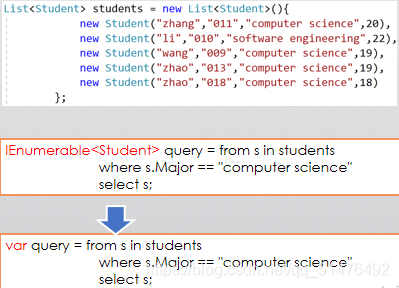c#的LINQ
本文共 543 字,大约阅读时间需要 1 分钟。
LINQ代表语言集成查询(Language Integrated Query)
LINQ是.NET框架的扩展,它允许我们以使用SQL查询数据库的方式来查询数据集合。 使用LINQ,你可以从数据库、对象集合以及XML文档中查询数据 2.语法 (1)from <迭代变量(新定义)> in <数据集合> where <条件> [orderby <元素的一部分] [select <整个元素或者元素的一部分>]



(2)方法中使用Lambda表达式
 上述语句等同于:
上述语句等同于: 

注意:(1)不写select语句表示返回的是数组/集合的元素。
(2)LINQ可以对多种存储数据的对象进行操作,如Objects,Dataset,SQL,Entities,XML。 当对类的对象进行操作时,即对于Linq to Objects, 返回数据类型是IEnumerable,T取决于select子句的结果。 一般使用推断类型var表示,编译器会自己判断类型
当对类的对象进行操作时,即对于Linq to Objects, 返回数据类型是IEnumerable,T取决于select子句的结果。 一般使用推断类型var表示,编译器会自己判断类型  (3)当where语句中的条件有多个时(用&&连接),可以分开写。
(3)当where语句中的条件有多个时(用&&连接),可以分开写。  3.结果数据转换 将IEnumerable类型的数据转换为List、Array、Dictionary
3.结果数据转换 将IEnumerable类型的数据转换为List、Array、Dictionary  4.结果数据计算 对IEnumerable类型的数据进行计数、求和、求平均、取第一个数据
4.结果数据计算 对IEnumerable类型的数据进行计数、求和、求平均、取第一个数据 
转载地址:http://osuaz.baihongyu.com/
你可能感兴趣的文章
nginx异常:the “ssl“ parameter requires ngx_http_ssl_module in /usr/local/nginx/conf
查看>>
nginx总结及使用Docker创建nginx教程
查看>>
nginx报错:the “ssl“ parameter requires ngx_http_ssl_module in /usr/local/nginx/conf/nginx.conf:128
查看>>
nginx报错:the “ssl“ parameter requires ngx_http_ssl_module in usrlocalnginxconfnginx.conf128
查看>>
nginx日志分割并定期删除
查看>>
Nginx日志分析系统---ElasticStack(ELK)工作笔记001
查看>>
Nginx映射本地json文件,配置解决浏览器跨域问题,提供前端get请求模拟数据
查看>>
nginx最最最详细教程来了
查看>>
Nginx服务器---正向代理
查看>>
Nginx服务器上安装SSL证书
查看>>
Nginx服务器的安装
查看>>
Nginx模块 ngx_http_limit_conn_module 限制连接数
查看>>
nginx添加模块与https支持
查看>>
Nginx用户认证
查看>>
Nginx的location匹配规则的关键问题详解
查看>>
Nginx的Rewrite正则表达式,匹配非某单词
查看>>
Nginx的使用总结(一)
查看>>
Nginx的使用总结(三)
查看>>
Nginx的使用总结(二)
查看>>
Nginx的可视化神器nginx-gui的下载配置和使用
查看>>